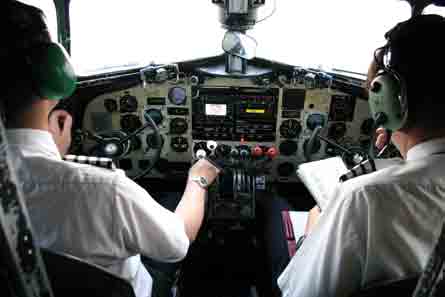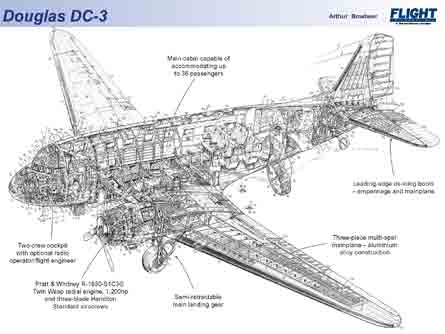Many examples of the venerable Douglas DC-3 are still in operation all over the world. So how does this classic aircraft fly compared with its modern counterparts?
The Douglas DC-3 is 71 years old - far older than the vast majority of pilots flying today. How does this pioneering aircraft, considered by many to be the first modern airliner, compare with the latest passenger-carrying types? And were pilots really pilots back when the DC-3 was in its heyday? Flight International set out to discover the answers.
|
|---|
A beast to handle on the ground, the Dak becomes a beauty to fly once level in still air |
The quest took me to the UK's Coventry airport, on a cool, blustery December day, to fly one of three DC-3s operated by Air Atlantique Classic Flight and owned by Michael Collett. My safety pilot was Kath Burnham, a pilot with more than 2,000h on the DC-3 and head of training for Air Atlantique. Her nerve was to be fully tested during the flight as I flew the complete sortie from the left-hand seat, but had never seen inside the beast before.
Our aircraft was a C-47 Dakota, the military transport version of the DC-3. There are still scores of "Daks" operating commercially around the world, some with more than 100,000h.
The secret of the DC-3's longevity lies in the fact that it has no main wing spar, just a complete mid-fuselage section manufactured as one piece, including inner wing and engine nacelles, on to which the outer wing sections are attached externally using more than 200 bolts per wing. In my walk-around check, I paid particular attention to making sure they were all tight. The aircraft is powered by two Pratt & Whitney R-1830 radials, each developing 1,200hp (895kW).
My first impression of the Dak was how big it was for a tailwheel aircraft, and how high the cockpit was off the ground. I was much taken by the crew escape hatch on the left-hand fuselage side, just behind the cockpit bulkhead, because if, during an evacuation, the still-turning left propeller (the tips just missing the hatch by inches) didn't kill you, the 25ft (7.6m) drop certainly would. The other impression was of a surface finish that wouldn't have gone amiss on a battleship. In these days of high-speed flight and carbonfibre composites, you forget just how basic structures were in that era and how akin they were to the cars and trucks of the time.
The aircraft sits on the ground at an angle of almost 12º nose-up so, after entry via the rear door, the pilot is faced with a climb to the cockpit that would put a scramble up the slopes of Mount Snowdon to shame. But after overcoming vertigo and getting there, the true character of the cockpit became evident. It reminded me of my father's Austin 7 (which had the same windscreen wipers): it seemed to have levers everywhere (12 just for the two engines) and was all done out in a delicate shade of black on black (I noticed a hint of blue on the artificial horizon, but that may have been a reflection). Most of the white lettering around the rows of identical switches had rubbed off, making Braille a useful skill to have.
Land Rover
The sliding cockpit side windows looked like they had been pinched from an old Land Rover and my pilot seat (1930s tractor-style) had a vertical adjustment for which the only direction was down (Kath acknowledged the 60-year-old supporting spring may have stretched a bit). Having made myself comfortable (in Spanish Inquisition terms) in the left seat, I finally got to look out of the front windscreen to see - not much at all. Field of view to the side and back behind the wingtip on that side was excellent, but visibility forward while on the ground, with such a nose-up attitude, was poor and through the opposite right-hand front windscreen bordered on non-existent (I made a mental note: taxi using left turns only).
|
|---|
Don't pull the first lever that comes to hand |
Kath demonstrated starting the right-hand engine and left me to start the other one. Somewhere in the sequence of start, prime, boost, propeller turns, magnetos, mixture and revs, I lost control of my fingers (add concert pianist to that required skills list), but with her help, I got it to fire. With the engines at idle, it was time to pressurise the hydraulics using a selection of the four levers (including the gear and flap operating handles) on the hydraulic panel BEHIND the co-pilot. The hydraulic pressures were easy to monitor because the gauges on the co-pilot's side had been taken off a U-boat.
With engine parameters stable (Kath assured me they were, since they were almost impossible to see behind the SS Titanic-type throttle box), we were ready to taxi. Wind was 20kt (37km/h) gusting to 30kt, and we were required to taxi downwind for runway 23. Differential braking using the toe brakes was effective, but with the rudder lock removed and no main control lock, holding the yoke and pedals in the gusts was a real problem. But differential engine power allied with the castoring tailwheel was a godsend and, with a dab of brake, really tight turns around the stationary inner main wheel were easy to accomplish using this technique.
Once into wind, the Dak turned back into a pussycat. Power was applied by the pilot flying (me) and completed by the co-pilot to give 48in of boost at 2,700rpm, and I immediately applied a large amount of forward push to bring the tail well up and level the aircraft by about 50kt indicated airspeed. Suddenly the forward field of view was outstanding! Rotate was at 82kt and the aircraft lifted off effortlessly. Gear was brought up by the co-pilot immediately because this is not an aircraft in which to have an engine failure after take-off with the gear still down.
There is little difference between the climb gradient of a fully loaded DC-3 and the curvature of the Earth, but with no passengers or cargo, an estimated all-up weight of 8,800kg and outside air temperature of 9ºC (48e_SDgrF), we climbed at about 1,200ft/min at 110kt, 35in boost and 2,350rpm up to 8,000ft.
On passing about 300ft, I got my first taste of perhaps the DC-3's biggest handling weakness - lateral control. Hit by a big side gust, I corrected with what I considered to be a large opposite lateral input on the yoke - and nothing much happened.
|
|---|
Under the supervision of Kath Burnham, this was Peter Collins' first time inside a DC-3 |
Massive freeplay
Later tests would show that, despite having ailerons that ran almost the complete length of the outer wing, the lateral control system had massive freeplay, higher control forces than the elevator (by about 3:1) and was slow to generate roll rate, which would reach 10-15º/s at best even at full lateral yoke deflection. It was the slowest rolling aircraft I have ever flown (apart from a sail-wing microlight, but then you shouldn't confuse a bed sheet powered by a lawnmower engine with aerodynamics).
In the climb, the DC-3 showed good control power and response in pitch and yaw, and huge amounts of static stability with high yoke forces in pitch away from trim speed. But, once trimmed and in stable air, the aircraft felt as if it could be flown hands-free all day. There was little Dutch roll, just a small amount of adverse yaw with aileron input and neutral spiral (banked) stability. In the climb, I noted how easy it was to grab the closest and highest set of levers to control engine boost, but then found they were the prop levers (the throttles were the middle pair).
We set up for stalling at 8,000ft. The clean stall was ideal: engines at idle distinct airframe buffet and vibration felt through the yoke and a positive pitch down without roll off at 50-55kt - a piece of cake. We then set up for a stall in approach configuration using flaps 1, 15in of boost, 20º left bank and about 10º pitch attitude.
Mental note
Now the pre-stall buffet was masked by the propeller slipstream and, if the pull was held to the stall, the aircraft rolled off smoothly and uncontrollably to about 70º left and 30-40º nose down. Recovery took more than 800ft of altitude and prompted another mental note.
We recovered to Coventry, where Kath first demonstrated and I then flew a simulated oil-spill "spray run" down the runway at 110kt and about 20ft. Starting from one side of the runway, the aircraft was skidded, wings level, to the other side to illustrate how kinks in the "fingers" of a spill can be captured when talked on to them by a spotter aircraft above. In this environment, the Dak's stability reigned supreme and the aircraft felt in its element. With an offload of 3,500kg of chemicals, the DC-3 continues to be effective in this commercial role for Air Atlantique when equipped with a rear spray boom.
A final circuit was made to land from 1,000ft downwind. Abeam the threshold, I selected flaps 1 (the flap indicator is a screw head in a vertical slot that moves up to indicate flap going down - a nice, logical touch, I thought), gear down, 18in of boost and performed a descending finals turn at 95kt to roll out at 400ft. Flaps 2, 3 and 4 are then selected in stages to slow the aircraft to a threshold speed of 75kt and a two-point landing attitude.
The touchdown was soft, but then the DC-3 "ground beast" reappeared. As the tail sank, the rudder lost effectiveness behind the wing at idle power, there was no active steering, use of differential brakes was inadvisable, the view forward returned to its "visible mountaintops only" mode and the tailwheel was still off the ground.
The technique, then, was to force the tailwheel on to the ground using decisive up elevator. The aircraft carries a 20kt crosswind landing limit and I can see why, because beyond 30kt it would become impossible to land successfully without exceptional pilot skill.
It was a pleasure and privilege to fly such a classic aircraft. Like many veteran designs, the DC-3 has low performance in outright terms, and many potential pilot "traps" that would never be seen in modern aircraft. Have we come a long way in aviation? Yes, we have. Were pilots really pilots back when the DC-3 first flew on 17 December 1935? Yes, they truly were.
Click on the cutaway to make larger.
Source: Flight International




















